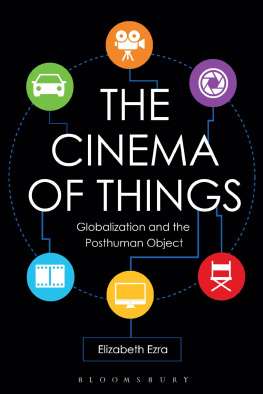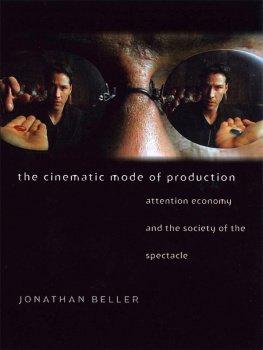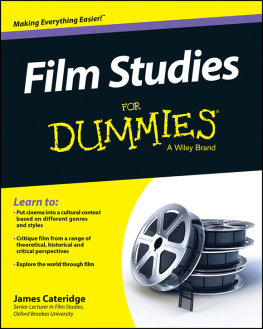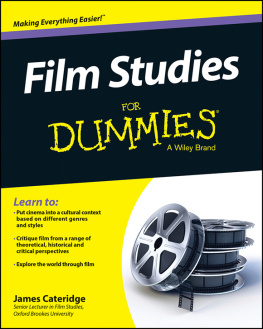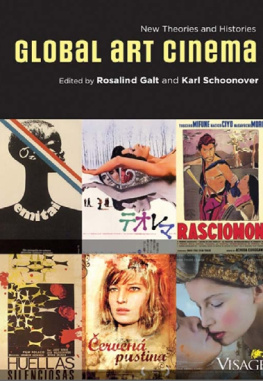The Cinema of Things
The Cinema of Things
Globalization and the Posthuman Object
Elizabeth Ezra
Bloomsbury Academic
An imprint of Bloomsbury Publishing Plc

Contents
This book began life as a collaborative project with Terry Rowden. As sometimes happens with these things, Terry and I gradually came to the mutual realization that we were writing two different books, and we finally decided to let those books go their separate ways. Happily, this book still bears the hallmarks of Terrys influence on nearly every single page, and I am enormously indebted to him for his unwavering intellectual support and friendship over the years, through various projects and across continents. It is no exaggeration to say that this book could not have been written without Terry.
For their very helpful feedback on the manuscript, I would like to extend huge thanks in particular to Sue Harris, Ana Salzberg, and Maggie Flinn, as well as to an anonymous reviewer at the press. Conversations with Antonio Sanchez also sparked a number of ideas that have enriched the book. For their comments on various portions of the manuscript through the mists of time, I wish to thank Dudley Andrew, Tom Conley, Diana Holmes, Michael Rothberg, Max Silverman, and Carrie Tarr. I am also grateful to Katie Gallof at Bloomsbury for her enthusiasm and support for the project, which made all the difference. All translations from the French in this book not otherwise credited are my own. Any errors in this book are also my own.
Portions of this manuscript have appeared in different forms in the following publications: Screen (The Case of the Phantom Fetish: Louis Feuillades Les Vampires, 2006, 47 [2]: 20111), Yale French Studies (Cleo's Masks: Regimes of Objectification in the French New Wave, 2010, 118/119: 17790), French Cultural Studies (Posthuman Memory and the Re(f)use Economy, 2014, 25 (3/4): 36886), and A Belle poque? Women and Feminism in French Society and Culture (Becoming Women: Cinema, Gender and Technology), ed. Diana Holmes and Carrie Tarr (New York and Oxford: Berghahn Books, 2006). I am grateful to the publishers for permission to reprint this material here. I am also pleased to acknowledge receipt of a generous grant from the Leverhulme Trust, which allowed me to pursue research that proved vital for this project.
My family has endured this book for what must seem like ages. My gratitude and love go to Simon, Nathan, and Paul, who constantly remind me that life is (mostly) other than what one writes.
This book traces the progressive redrawing of the boundaries between humans and objects as represented in cinema from the end of the nineteenth century, when French cinema dominated the global film industry, to the first decades of the twenty-first century, when Hollywoods hold on world film markets remains firm, despite some important competition from other national cinemas. During this period, globalization has made it increasingly difficult to distinguish the center from the periphery, a pairing whose boundaries have been blurred by the overdetermined networks of communication that crisscross the planet. This period also coincides with what Steven Connor calls the thingly turn in recent theory (Connor 2009: n.p.). Human beings relate to things, objects, and stuff in a number of ways: through hyperconsumption; through structures of racial and sexual objectification that reduce people designated as others to objects of fascination, sexual gratification, or labor; and through information technology that replaces human agency with encoding. By exploring the border zones between life (specifically human life) and nonlife, it is possible to gain an understanding of the ways that commodities take on a life of their own, engulfing and ultimately replacing the people they were meant to supplement; of the exploitation of human beings for their use value as pure bodies, whether for entertainment, for labor, or in war time; and of the creation of technological supplementation, digital worlds, and artificial life. It is possible, in other words, to gain an understanding of the ways in which humans are prosthetically engaged with life beyond the human in the global age.
In virtual realms such as economics, communication, and the media, the obstructive force of national borders is becoming increasingly limited. Whereas transnationalisms mandate is to reconfigure the nation into global viability, globalizations mandate is to reduce the nation to pure nominalism. Globalization allows for the positive recognition of landless aggregates and provisional assemblages as well as the all-encompassing force of technology. If transnationalism has its greatest use value in considering the movement of bodies and objects across discrete but virtual lines, globalization is most useful for considering how the world is becoming economically and technologically unified in ways that smudge those lines into unreadability. The utopian imaginary of transnationalism is that the (united) nations will take their place on a monopoly board in which flows of diasporized capital and people will move nonoppositionally through clearly demarcated and stabilized national units. The utopian imaginary of globalization is that at some point the strands of the global rhizome will meet and create a perfectly networked path for unimpeded access and consumption.
Globalization, as the endpoint of capitalism, is revealed by the various degrees and ways in which the porosity of national borders is being exploited. The term globalization expresses the aporia of a constant movement toward an imaginary wholeness and plenitude (a unified globe), an endless supplementation that strives for wholeness at the same time that it undermines the very possibility of wholeness. Globalization, a very human endeavor, thus shares a supplementary structure with humanity itself: the logic of the supplement underpins the traditional definition of human beings as creatures who make and use tools (Wynn 1994: 13361). Although this definition has come to be challenged in recent years (see Goodall 1992), its influence on philosophy and anthropological humanism cannot be overstated. Tools extend human capabilities, enhancing existing attributes and compensating for perceived deficiencies; it is through supplementation that humans both complete themselves and acknowledge their incompleteness. This dynamic is the essence of supplementarity according to Jacques Derrida (1997: 14157; 31316). The Derridean term supplement has itself been supplemented in recent years by Bernard Stieglers term prosthesis, which refers specifically to the relationship between humans and the objects with which they surround themselves (Stiegler 1998, passim; see also Wills 1995, passim). Like the supplement, which is intended to enhance or complete something previously thought to be complete but whose supplementation both reveals and creates its retrospective incompletion, prosthesis is that which provides an alternative to something deemed inadequate.
In an apparent paradox, the supplementary nature of the human endeavor of globalization is precisely what makes us posthuman. According to N. Katherine Hayles, In the posthuman, there are no essential differences or absolute demarcations between bodily existence and computer simulation, cybernetic mechanism and biological organism, robot teleology and human goals (Hayles 1999: 3). Like the posthuman, globalization problematizes boundary maintenance, and both discourses challenge and build upon the existing systems (whether epistemological or world-historical) of humanism and transnationalism, respectively. Where transnationalism produces an oscillation between the need to transcend borders and the drive to maintain them, globalization is the will to eradicate borders altogether. As the posthuman uses prosthesis to extend beyond the human, globalization extends beyond the nation in reconceptualizing life beyond the local.

